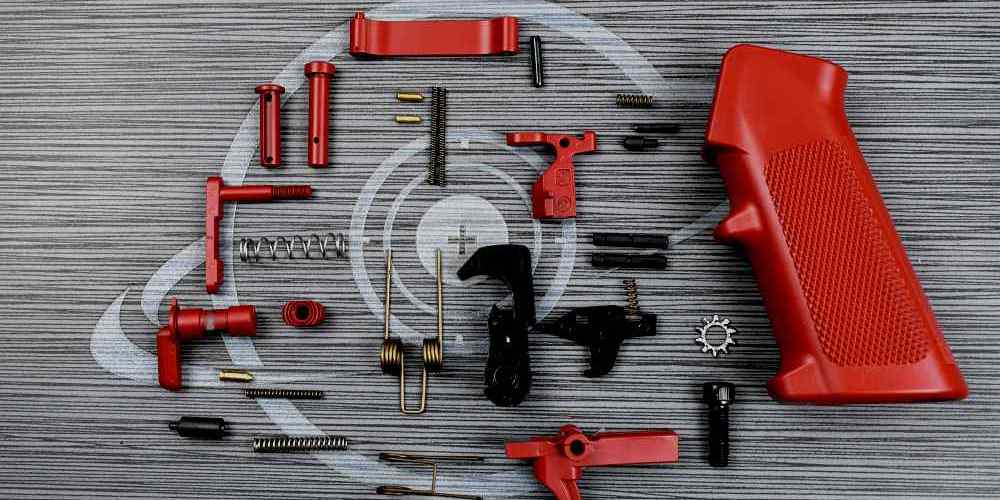“AR15 Lowers: Lightweight and Stylish, but Sacrificing Durability”
Lightweight and Maneuverable Design
When it comes to customizing your AR15 rifle, one of the decisions you’ll need to make is whether to go with a skeletonized lower receiver. This design option has become increasingly popular among gun enthusiasts due to its lightweight and maneuverable nature. However, like any modification, there are both pros and cons to consider before making your final decision.
One of the biggest advantages of a skeletonized lower receiver is its weight savings. By removing excess material from the lower receiver, manufacturers are able to significantly reduce the overall weight of the rifle. This can be a game-changer for those who need to carry their rifle for extended periods or who are looking to reduce fatigue during long shooting sessions. The lighter weight also makes the rifle more maneuverable, allowing for quicker target acquisition and improved handling in tight spaces.
In addition to weight savings, skeletonized lowers can also offer improved aesthetics. The intricate designs and patterns created by the skeletonization process can give your rifle a unique and custom look that sets it apart from the standard AR15. This can be a great way to personalize your rifle and make it stand out at the range or in competition.
However, there are some potential drawbacks to consider when it comes to skeletonized lowers. One of the main concerns is durability. By removing material from the lower receiver, you are inherently weakening the structure of the rifle. This can make the rifle more prone to damage from impacts or rough handling. While most skeletonized lowers are still plenty strong for normal use, they may not hold up as well under extreme conditions.
Another potential downside is cost. Skeletonized lowers are typically more expensive than their solid counterparts due to the additional machining and design work required. This can be a significant factor for budget-conscious shooters who are looking to keep costs down. However, for those who value the weight savings and aesthetics of a skeletonized lower, the added cost may be worth it.
In conclusion, skeletonized lowers offer a number of benefits for those looking to customize their AR15 rifle. The weight savings and improved maneuverability can make a big difference in performance, while the unique designs can add a touch of personalization to your firearm. However, it’s important to weigh these advantages against the potential drawbacks, such as reduced durability and higher cost. Ultimately, the decision to go with a skeletonized lower will depend on your individual needs and preferences.
Enhanced Aesthetics and Customization Options
When it comes to customizing your AR15 rifle, one of the options you may come across is skeletonized lowers. These lowers have cutouts or patterns that reduce weight and provide a unique look to your firearm. While skeletonized lowers can enhance the aesthetics of your rifle, there are also some drawbacks to consider. In this article, we will explore the pros and cons of skeletonization in AR15 lowers.
One of the main advantages of skeletonized lowers is the enhanced aesthetics they provide. The cutouts and patterns on these lowers can give your rifle a sleek and modern look that sets it apart from traditional AR15s. Whether you prefer a minimalist design or a more intricate pattern, there are plenty of options available to suit your personal style.

In addition to their visual appeal, skeletonized lowers also offer practical benefits. By reducing the amount of material used in the lower receiver, these lowers are lighter than their solid counterparts. This can be especially beneficial for shooters who need to carry their rifle for extended periods or who are looking to reduce the overall weight of their firearm.
Another advantage of skeletonized lowers is the increased airflow they provide. The cutouts and patterns allow for better ventilation, which can help prevent overheating during extended shooting sessions. This can be particularly useful for competitive shooters or those who engage in rapid-fire shooting.
Despite these benefits, there are some drawbacks to consider when it comes to skeletonized lowers. One of the main concerns is the potential for reduced durability. The cutouts and patterns in these lowers can weaken the overall structure, making them more prone to damage or failure under heavy use. This is something to keep in mind if you plan on using your rifle in high-stress situations or harsh environments.
Another drawback of skeletonized lowers is the limited customization options. While the cutouts and patterns can add a unique touch to your rifle, they may also limit your ability to add additional accessories or modifications. For example, some aftermarket parts may not be compatible with skeletonized lowers, which can restrict your ability to fully customize your firearm.
In conclusion, skeletonized lowers can be a great option for shooters looking to enhance the aesthetics of their AR15 rifle. With their sleek design, lightweight construction, and improved airflow, these lowers offer several benefits that can appeal to a wide range of shooters. However, it is important to consider the potential drawbacks, such as reduced durability and limited customization options, before making a decision. Ultimately, the choice between a skeletonized lower and a traditional solid lower will depend on your personal preferences and shooting needs.
Potential Reduction in Durability and Strength
When it comes to AR15 lowers, one of the key decisions that firearm enthusiasts must make is whether to opt for a skeletonized design. Skeletonization involves removing excess material from the lower receiver to reduce weight and improve aesthetics. While this can offer some benefits, there are also potential drawbacks to consider.
One of the main concerns with skeletonized AR15 lowers is the potential reduction in durability and strength. By removing material from the lower receiver, there is a risk of weakening the overall structure of the firearm. This can lead to issues such as increased recoil, decreased accuracy, and even potential malfunctions.
It is important to note that not all skeletonized AR15 lowers are created equal. Some manufacturers use high-quality materials and precision machining techniques to ensure that the lower receiver remains strong and reliable. However, there are also lower-quality options on the market that may sacrifice durability for the sake of weight reduction.
When considering a skeletonized AR15 lower, it is crucial to do your research and choose a reputable manufacturer. Look for reviews and feedback from other firearm enthusiasts to get a sense of the quality and reliability of the product. Additionally, consider the intended use of the firearm – if you plan on using it for heavy-duty applications such as hunting or competitive shooting, you may want to opt for a more traditional, solid lower receiver.
Another potential drawback of skeletonized AR15 lowers is the increased risk of damage. Because there is less material to absorb impact and recoil, a skeletonized lower receiver may be more prone to dents, scratches, and other forms of damage. This can affect the overall appearance and functionality of the firearm, potentially leading to costly repairs or replacements.
On the flip side, one of the main advantages of skeletonized AR15 lowers is the significant reduction in weight. By removing excess material, these lowers are lighter and more maneuverable, making them ideal for applications where weight and mobility are key factors. This can be particularly beneficial for competitive shooters or those who need to carry their firearm for extended periods.
In conclusion, the decision to opt for a skeletonized AR15 lower comes down to a balance of pros and cons. While the reduction in weight can offer benefits in terms of maneuverability and comfort, there are potential drawbacks in terms of durability and strength. It is important to carefully consider your needs and preferences before making a decision, and to choose a high-quality product from a reputable manufacturer. Ultimately, the choice between a skeletonized and solid AR15 lower will depend on your individual priorities and intended use of the firearm.
Improved Heat Dissipation and Recoil Management
When it comes to customizing your AR15 rifle, one of the decisions you may face is whether to opt for a skeletonized lower receiver. This design choice can have a significant impact on the performance of your firearm, particularly in terms of heat dissipation and recoil management. In this article, we will explore the pros and cons of skeletonization in AR15 lowers, focusing on how it can improve these two key aspects of rifle performance.
One of the primary advantages of skeletonized AR15 lowers is their improved heat dissipation capabilities. By removing excess material from the lower receiver, manufacturers are able to create a more open and ventilated design that allows for better airflow around the internal components of the rifle. This can help to prevent overheating during extended shooting sessions, which can be particularly beneficial for those who engage in rapid-fire or high-volume shooting.
In addition to improved heat dissipation, skeletonized AR15 lowers can also offer better recoil management. The reduced weight of the lower receiver can help to minimize the overall weight of the rifle, which in turn can lead to less felt recoil when firing. This can make the rifle more comfortable to shoot, particularly for those who are sensitive to recoil or who are looking to improve their accuracy and follow-up shot speed.
However, it is important to note that there are also some potential drawbacks to skeletonized AR15 lowers. One of the main concerns is that the reduced material in the lower receiver can make it less durable than a solid, non-skeletonized design. This can be particularly problematic for those who plan to use their rifle in harsh or demanding environments, as the lower receiver may be more prone to damage or wear over time.
Another potential downside to skeletonized AR15 lowers is that they may be more expensive than traditional solid lowers. The additional machining and design work required to create a skeletonized lower receiver can drive up the cost of the rifle, which may be a deterrent for budget-conscious shooters. However, for those who prioritize performance and customization options, the added cost may be worth it in the long run.
In conclusion, skeletonized AR15 lowers can offer significant benefits in terms of improved heat dissipation and recoil management. By reducing the weight and increasing the ventilation of the lower receiver, these designs can help to enhance the overall performance of your rifle. However, it is important to weigh these advantages against the potential drawbacks, such as reduced durability and higher cost. Ultimately, the decision to opt for a skeletonized lower receiver will depend on your individual preferences and shooting needs.
Legal Considerations and Restrictions on Skeletonized Lowers
When it comes to AR15 lowers, one of the design options that has gained popularity in recent years is skeletonization. This process involves removing excess material from the lower receiver to reduce weight and improve aesthetics. While skeletonized lowers can offer some benefits, there are also legal considerations and restrictions that gun owners need to be aware of before purchasing or using one.
One of the main advantages of skeletonized lowers is their reduced weight. By removing material from the lower receiver, manufacturers are able to create a lighter and more maneuverable firearm. This can be particularly beneficial for shooters who need to carry their AR15 for extended periods or who are looking to build a more compact and lightweight rifle.
In addition to weight savings, skeletonized lowers can also offer a unique and eye-catching appearance. The intricate patterns and designs created by the removal of material can give a firearm a custom look that sets it apart from more traditional AR15 builds. This can be a major selling point for gun owners who are looking to personalize their firearms and make a statement at the range.
However, despite these benefits, there are some legal considerations and restrictions that gun owners need to be aware of when it comes to skeletonized lowers. One of the main concerns is whether or not a skeletonized lower meets the legal definition of a firearm. In the United States, the lower receiver is considered the serialized part of the AR15 and is therefore subject to federal regulations.
If a skeletonized lower does not meet the legal definition of a firearm, it may not be subject to the same regulations and restrictions as a traditional lower receiver. This could potentially create legal issues for gun owners who unknowingly purchase or use a skeletonized lower that does not comply with federal laws.
Another potential issue with skeletonized lowers is their structural integrity. By removing material from the lower receiver, manufacturers may compromise the strength and durability of the firearm. This could lead to malfunctions or even catastrophic failures during use, putting the shooter and those around them at risk.
To address these concerns, some manufacturers have developed skeletonized lowers that are reinforced with additional material or designed in a way that maintains the structural integrity of the firearm. These enhanced designs can offer the benefits of reduced weight and improved aesthetics without sacrificing safety or compliance with federal regulations.
In conclusion, skeletonized AR15 lowers can offer some benefits in terms of weight savings and aesthetics. However, gun owners need to be aware of the legal considerations and restrictions that come with these unique designs. By ensuring that a skeletonized lower meets the legal definition of a firearm and is structurally sound, shooters can enjoy the advantages of this innovative design while staying safe and compliant with the law.




